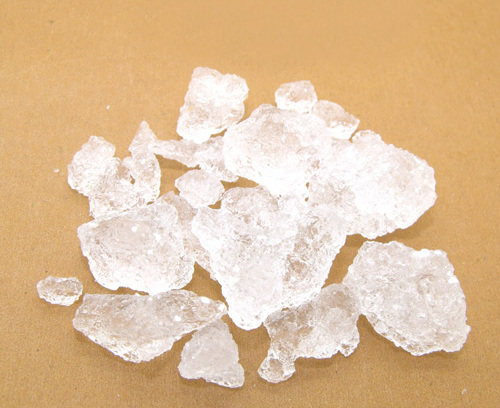Glauber salt refers to the refined crystals from the natural mineral containing sodium sulfate. It mainly contains sodium sulfate decahydrate (Na2SO4?10H2O). As a result, other names of this mineral medicine include mirabilite, Natrii Sulfas, sodium sulfate decahydrate, Sodium Sulfate, and so on. In China it is mainly produced in Hebei, Henan, Shandong, Jiangsu, Anhui and other places.
According to different processing steps, it is called by different names. First, dissolve the natural mineral in hot water, filter, cool down, and then crystallize. This product is called Pi Xiao. Secondarily, clean and slice the radish, place them and Pi Xiao into the pot, add water and boil, take the liquid in the upper layer, cool down, and crystallize. The crystal obtained is glaubers salt. The preferred one is bluish-white, transparent, in the shape of block crystal, clean and free of impurities. Thirdly, glauber salts lose the crystal water by weathering and turn into the white powder, which is known as anhydrous sodium sulfate (Xuan Ming Fen).

Glauber Salt
GLAUBER SALT HEALTH BENEFITS
According to reports, glauber’s salt-based formulas can be used to treat a variety of diseases. For example, the total effective rate was 79% in the treatment of 117 cases of Kashin-Beck disease by taking it by orally, twice a day, 2 to 4 grams each time in adult (1); Jin Bo Xiao Shi San, composed of 100g mirabilite, 100g Hai Jin Sha (Lygodium japonicum), 40g Hu Po (Amber), and 20g Peng Sha (sodium borate), is a good cure for urolithic stranguria (2); it is also used to treat mumps, ascariasis, intractable pruritus, and so on.
GLAUBER SALT HERBAL REMEDIES
According to the Chinese Pharmacopoeia, it is salty and bitter in flavor and cold in nature. And it goes to stomach and large intestine. Basic functions are purgating heat and bowels, moistening dryness, softening hard mass and clearing heat for detumescence. Essential indications include excess-heat causing Constipation, dry feces, abdominal pain due to indigestion, swelling and pain in appendicitis, and externally for mastitis and painful swollen Hemorrhoids. Recommended dosage is from 6 to 12 grams. And generally it is not used as decoction. Instead it is highly recommended to dissolve it in the decoction after it is done.
1. Da Cheng Qi Tang and Tiao Wei Cheng Qi Tang from Shang Han Lun (On Cold Damage). It is mainly formulated with Da Huang (Rhubarb) to enhance the laxative effect. And in recent years it is also frequently used for abdominal pain and constipation in cholelithiasis patients.
2. Bing Peng San from Wai Ke Zheng Zong (Orthodox Exogenous Illnesses). It is combined with sodium borate, Bing Pian (Borneol), and Zhu Sha (Cinnabar) to cure sore throat and mouth sores.

![Diseases, Symptoms, tcm, [tcmwindow.com]](/uploadFile/adImg/2015/11/11/f5cbfcc0-4df5-4646-9b9a-f316651a0199.jpg)





